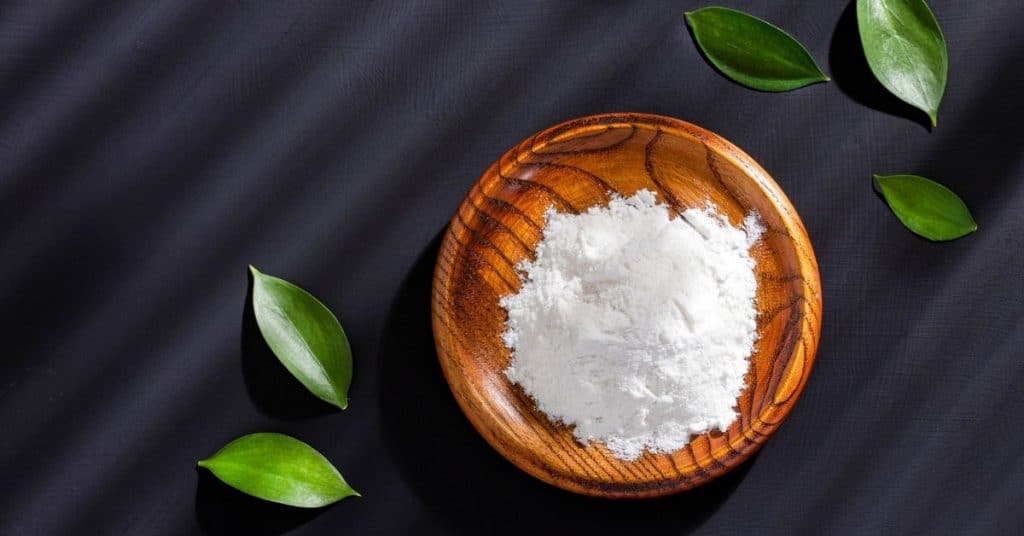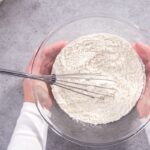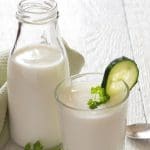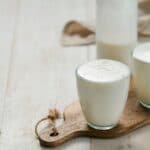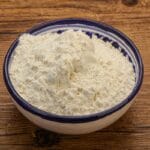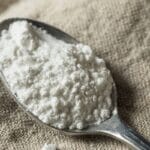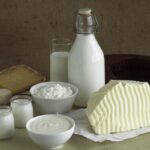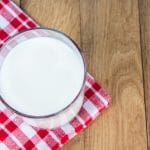Key points:
- Baking soda can be combined with buttermilk, plain yogurt, molasses, cream of tartar, sour milk, vinegar, or lemon juice for similar effects.
- Club soda, self-rising flour, and whipped egg whites are also alternatives. Each substitute requires adjustments to other recipe ingredients, so choose according to your needs and desired outcome.
Baking powder is an easy way to add volume and airiness to baked goods. This convenient leavening agent is a quick solution to baking fluffy, well-risen cakes and bread without needing yeast.
Leaving baking powder out of a dish when the recipe calls for it can be disastrous. You will most likely end up with a dense, flat, and tough product.
Whether your baking powder has expired or you’ve just run out, don’t head out to the store yet, because there is a range of substitutes you can use just as successfully to achieve a beautiful rise.
In this article, we’ve rounded up the best substitutes for baking powder when you’re in a pinch.
What Is Baking Powder?
Baking powder is a combination of baking soda with a water-activated acid. Sometimes, corn starch is added to the dry product as a filler. Baking powder serves as an instant leavening agent in baked goods including cakes, bread, muffins, pancakes, and cookies.
Sodium bicarbonate (also known as baking soda) forms the base ingredient. This is paired with an acid such as cream of tartar to form a reaction and release carbon dioxide gas when it comes into contact with water. The release of the gas forms bubbles which cause the batter to expand. As the air gets trapped during the baking process, it adds volume to the dough.
Baking Powder Substitutes With Baking Soda
Baking soda consists only of sodium bicarbonate and does not contain the acid component needed to function as a raising agent.
If you don’t have baking powder on hand, but you have baking soda, there are several ingredients you can combine to make your own baking powder variant for the same leavening effect.
1. Buttermilk
Buttermilk is a fermented milk product with a slightly tangy, sour taste. Due to its acidity, the combination of buttermilk with baking soda produces the same leavening reaction as baking powder.
How to substitute 1 teaspoon (5 g) of baking powder:
Mix ½ cup of buttermilk and ¼ teaspoon of baking soda. Add the buttermilk mixture to the rest of the ingredients.
To maintain the correct texture and consistency, you will need to decrease the amount of other liquid in the recipe to compensate for the extra buttermilk. If you add a ½ cup of buttermilk, reduce the amount of other liquids in your recipe by the same amount.
See more: Buttermilk replacement
2. Plain Yogurt
The acidity of plain yogurt makes it a good substitute for baking powder when mixed with baking soda. Plain yogurt is the best type of yogurt to use in this case since it won’t affect the flavor of your dish.
How to substitute 1 teaspoon (5 g) of baking powder:
Use ¼ teaspoon baking soda mixed with ½ cup plain yogurt as your substitute. To maintain the correct texture and consistency, you will need to decrease the amount of other wet ingredients in the recipe to compensate for the yogurt. If you add a ½ cup of yogurt, reduce the amount of other liquids in your recipe by the same amount.
3. Molasses
Molasses is a by-product of sugar production. It is sometimes used instead of refined sugar. Due to its acidity, it can be used as a catalyst for the acid-base reaction when paired with baking soda.
How to substitute 1 teaspoon (5 g) of baking powder:
Use ¼ cup (84 grams) molasses with ¼ teaspoon (1 gram) baking soda to replace 1 teaspoon baking powder.
In addition to reducing the amount of liquid in your recipe to balance the added liquid from molasses, you also need to reduce the sugar in the rest of the recipe, since molasses is high in sweetness.
Related: What can I substitute for molasses?
4. Cream of Tartar
Cream of tartar is an acidic white powder produced as a by-product of winemaking. It is often used to stabilize creams, egg whites and prevent the formation of sugar crystals.
Using cream of tartar is an easy way to substitute baking powder since it does not require you to adjust any other ingredients in the recipe. Using more than the recommended amount can unpleasantly change the flavor of your recipe.
How to substitute 1 teaspoon of baking powder:
Use a 2:1 ratio of cream of tartar to baking soda for the best result. Replace 1 teaspoon baking powder with ¼ teaspoon baking soda plus a ½ teaspoon cream of tartar.
Related: Cream of tartar substitute
5. Sour Milk
If you are baking, don’t throw away milk that has gone sour. You can successfully use it as a leavening agent to replace baking powder. Once the milk sours, it becomes more acidic allowing it to react favorably with baking soda for the perfect rise.
You can make your own sour milk by adding 1 tablespoon of vinegar or lemon juice to a cup of regular milk. Let it stand for a few minutes while measuring out your recipe before using it as you would sour milk or buttermilk.
How to substitute 1 teaspoon (5 g) of baking powder:
Mix ¼ teaspoon (1 gram) baking soda in ½ cup (122 grams) of sour milk. Add the mixture to the rest of your ingredients. Remember to reduce the amount of overall liquid required in your recipe by the same amount of sour milk that you added.
6. Vinegar
Vinegar is made by a fermentation process that produces a very strong acidic flavor. Use white vinegar for baking since it has a neutral flavor and won’t affect the color of your batter. Alternatively, you can also use apple cider vinegar.
How to substitute 1 teaspoon (5 g) of baking powder:
Mix ¼ teaspoon (1 gram) baking soda with ½ teaspoon (2.5 grams) vinegar and add it to your recipe. No further recipe adjustments will be required.
7. Lemon Juice
As with vinegar, lemon juice has a high level of acidity and should only be used in small amounts to prevent altering the flavor of your final product.
How to substitute 1 teaspoon (5 g) of baking powder:
Mix ¼ teaspoon (1 gram) baking soda with ½ teaspoon (2.5 grams) lemon juice. Add it to the rest of the ingredients. No further recipe adjustments will be required with this baking soda lemon juice combination.
Best Baking Powder Alternatives Without Baking Soda
8. Club Soda
Club soda is a carbonated beverage that contains a very small amount of baking soda. Since the amount of baking soda in the drink is so small, it is best to use this substitute in recipes that require only a little rise such as pancakes or coating batters for frying.
If you require a lot of volume in products like cake or bread, it is best to use an alternative substitute.
Use the club soda in place of any liquid in your recipe. This baking powder replacement works well when replacing milk or water.
9. Self-Rising Flour
Self-rising flour is made from all-purpose flour, baking powder, and salt. It is often used in premade cake-, biscuit-, and bread mixes.
If you don’t have baking powder, simply replace the regular flour in your recipe with self-rising flour and leave out any baking powder or baking soda called for in the recipe.
Related: Self rising flour substitute
10. Whipped Egg Whites
Whipped egg whites are a popular way to give rise and airiness to recipes such as angel food cake, meringues, and souffle. Whipping up the egg whites creates tiny air bubbles. This increases the volume and decreases the density.
The amount you should use will vary according to the recipe. Items like angel food cake use up to 12 egg whites, while pancake batter only needs two to three egg whites.
Once your egg whites are beaten to a soft peak stage, gently incorporate the rest of the ingredients.
Tip: When folding the other ingredients into your egg whites, do not use a wooden spoon and do not mix vigorously. Using a spatula or thin spoon with light folding movements will ensure that you do not lose all the air that has just been incorporated into the eggs.
FAQs
If you are worried that your baking powder has expired, test it before adding it to your recipe. Drop ½ teaspoon into ½ cup of hot water. The mixture should start to bubble straight away. If the mixture does not bubble, it’s time to throw it away and use a substitute instead.
Baking soda and powder are best used within six months of opening. After this, it will start losing its potency as a raising agent.
Using too much or too little baking powder can really mess up your cake’s flavor and texture. As a general guideline, add 1 teaspoon (5 – 6ml) for every 1 cup (250 ml) of all-purpose flour.
A substitute for 1 tablespoon of baking powder can be a mixture of 1/4 teaspoon of baking soda and 1/2 teaspoon of cream of tartar. This combination can be used in recipes that call for baking powder when you don’t have it on hand.
Conclusion
Baking powder is a vital ingredient to give baked goods their much-loved fluffy texture. Always store it in a dry, cool place. Check the expiration date before using it since expired powder loses its properties as a raising agent.
Some baking powder substitutes work better in certain recipes than others. A baking soda variation works well in most cases, as long as you adjust the liquid ratio where necessary. Now you know how to get the perfect rise without baking powder. Happy baking!
Up next:

*image by Luisecheverriurrea/depositphotos
